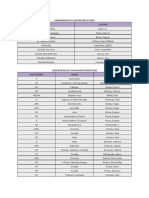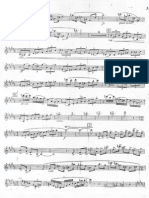Program Notes
Uploaded by
Brett JacksonProgram Notes
Uploaded by
Brett JacksonProgram Notes Concerto for Oboe in D Minor (c1717) Alessandro Marcello was an Italian nobleman, politician, poet, mathematician
and composer born in Venice in 1669. His Concerto in C Minor has been falsely attributed to several composers, including Bach, Vivaldi and his brother, Benedetto. The confusion most likely comes from Alessandros inconsistent use of the pseudonym Eterio Stinfalico on his compositions. Despite its dubious origins, Concerto in C Minor is a staple of the oboe repertoire and the Adagio movement has become part of the canon of wedding music. Harvey Pittel is responsible for this transcription for soprano saxophone and piano in the key of C minor. Pittel studied music education and achieved a Doctorate from the University of Southern California. His former private instructors include Frederick Hemke and Joseph Allard. Sarabande and Gigue (1976) Fischer Tull is an American composer born in Waco, Texas in 1934. Tull received his formal musical training at North Texas State University, initially working as staff arranger for the NTSU Lab Bands. He returned to NTSU in 1962 to complete his doctorate, studying under Samuel Adler. Tull has received numerous awards for his compositions including five First Prize awards from the Texas Composers Guild and nine ASCAP awards. In 1970, his Toccata for Band won the ABA Ostwald Award. Sarabande and Gigue is based on traditional Baroque dances, but there are many contemporary compositional techniques employed. Tull takes the regular meters of 3/4 and 6/8 respectively and replaces them with 5/8 (subtracting one eighth note) and 7/8 (adding one eighth note). Harmonically, the movements are centered in the Lydian mode, making use of the raised 11th chord tone, a sound that would have been unheard of in the days of the Baroque. This piece also utilizes extended techniques for the saxophone, including slap tonguing and altissimo, extending the range of the saxophone to three and one-half octaves. The piece was written in 1976 for Kenneth Deans who premiered the work at the World Saxophone Congress with Raymond Gotko at the piano. Ballade for Saxophone and Orchestra (1938) Henri Tomasi was a composer and conductor of Corsican descent, born in Marseille, France in 1901. Among his mentors were Vincent dIndy and Paul Vidal. In 1927, while studying at the Conservatoire de Paris, Tomasi won the Prix de Rome. In 1932, he became one of the founding members of the Triton Group of Contemporary Music along with Honegger, Milhaud, Poulenc, Prokofiev and others. Tomasi divided his time between composing and conducting, directing performances in opera houses around the world. Tomasi had a special affinity for the theatre and composed several operas. Ballade for Saxophone and Orchestra was inspired by a poem written by Suzanne Malard, Tomasis wife: On an old English theme, long, thin and phlegmatic like him a clown tells his melancholy tale in the night. The shadow of his fate, the length of the zigzagging quays and the taste
of the fag-end that in his mouth has taken up old jests makes him mad. To get away from his coat, too big, and his dull flesh while only being, between joy and sorrow, a saxophone hesitating! His despair, to the bottom of a sounding pool sinks right down. And the clown resigns himself again to making the public laugh. Tomasi expresses great emotional highs and lows, and the saxophone is well adapted to this role. The composer utilizes the great dynamic and timbral range of the saxophone to bring the tortured clown to life. The piece was written for the French saxophonist, Marcel Mule and was premiered in 1939 with the composer conducting. In 1958, Mule selected Ballade to be part of a twelve concert tour of the United States with the Boston Symphony. Mule performed the work, along with Iberts Concertino da Camera, under the direction of Charles Mnch. Arrival Platform Humlet (1908-12) Percy Aldridge Grainger spent his early years in Melbourne, Australia, where he was educated by his mother, Rose. Grainger received tutorials in languages, art, drama, elocution and the piano (with Louis Pabst). After making his piano debut in Melbourne in 1894, Grainger attended the Hoch Conservatory in Frankfurt, where he studied piano with James Kwast and composition with Iwan Knorr. Grainger was based in London from 1901 to 1914. During this time, he collected and arranged English folksongs. Arrival Platform Humlet is part of this collection. Grainger writes an introduction to the piece: Awaiting arrival of belated train bringing ones sweetheart from foreign parts; great fun! The sort of thing one hums to oneself as an accompaniment to ones tramping feet as one happily, excitedly, paces up and down the arrival platform. Arrival Platform Humlet was originally conceived for solo viola, though arrangements exist for many instrumental combinations, including a realization for piano, Degan percussion, and orchestra by Grainger himself. This transcription was produced by Roger Greenberg, a saxophonist and professor emeritus at the University of Northern Colorado. Greenbergs musical career has included performances with the Tommy Dorsey Orchestra, the CBS-TV Orchestra, the Los Angeles Saxophone Quartet, the West Point Band and studio work under the direction of John Williams, Jerry Goldsmith and Lalo Schifrin. Greenberg is currently a member of the Harvey Pittel Saxophone Quartet. Victor Moroscos Blue Caprice will not be performed today. Instead, the Jazz Combo will perform selections following the Saxophone Quartet.
Andante et Scherzo (1943) French composer Eugene Bozza was born in Nice in 1905. His studies at the Paris Conservatoire consisted of violin, conducting and composition and he won premiers prix for each. Bozza also won the Prix de Rome with his composition La lgende de Roukmni (1934). From 1938 to 1948, Bozza conducted the Opra-Comique in Paris and in 1951 he became the director of the Ecole Nationale de Musique in Valenciennes, a position he held until his retirement in 1975. Bozza is known over the world for his chamber music for winds, though he wrote many large-scale works which are still popular in France. Andante et Scherzo was composed in 1938 and is dedicated to the Paris Saxophone Quartet, a group that was headed by Marcel Mule. The Andante begins with a soaring melody played by the tenor which is carried forward by the soprano and finally by the baritone. The lively Scherzo places the virtuosity of the four saxophonists in the forefront. Selections from the Jazz Combo: Day Dream (1941).Duke Ellington and Billy Strayhorn Voyage (1986)Kenny Barron Andrew Ouellette, piano Andrew Stinson, bass Brian Steever, drums
You might also like
- Baptiste Septieme Solo de Concert Baritone Piano100% (2)Baptiste Septieme Solo de Concert Baritone Piano7 pages
- La Tempesta Di Mare (A. Vivaldi) (Cuarteto Saxos)100% (1)La Tempesta Di Mare (A. Vivaldi) (Cuarteto Saxos)32 pages
- Youshimatsu Fuzzy Bird Sonata Pour Saxophone Alto en Mib Et Piano Alto Saxophone PianoNo ratings yetYoushimatsu Fuzzy Bird Sonata Pour Saxophone Alto en Mib Et Piano Alto Saxophone Piano36 pages
- PDF Caprice en Forme de Valse For Solo Saxophone PDFNo ratings yetPDF Caprice en Forme de Valse For Solo Saxophone PDF3 pages
- C.T.smith, Fantasia For Alto Saxophone - Sax BaritonoNo ratings yetC.T.smith, Fantasia For Alto Saxophone - Sax Baritono3 pages
- Frederick The Great - Adagio and Allegro (Alto Saxophone & Piano) PDFNo ratings yetFrederick The Great - Adagio and Allegro (Alto Saxophone & Piano) PDF5 pages
- Akira Yuyama Divertimento For Marimba and Alto Saxophone Alto Saxophone Amp Pianopdf PDFNo ratings yetAkira Yuyama Divertimento For Marimba and Alto Saxophone Alto Saxophone Amp Pianopdf PDF19 pages
- THE TEACHING OF SAXOPHONE OVER TIME: From Adolphe Sax to the present dayFrom EverandTHE TEACHING OF SAXOPHONE OVER TIME: From Adolphe Sax to the present dayNo ratings yet
- Le Carnaval de Venice (Jules Demersseman) - Alto Sax and PianoNo ratings yetLe Carnaval de Venice (Jules Demersseman) - Alto Sax and Piano12 pages
- Rapsodie - Paul Creston (Pour Saxophone Alto Et Piano) PDFNo ratings yetRapsodie - Paul Creston (Pour Saxophone Alto Et Piano) PDF25 pages
- Johann Sebastian Bach - Sonate Flute Et Basse Continue (Alto Saxophone & Piano) PDFNo ratings yetJohann Sebastian Bach - Sonate Flute Et Basse Continue (Alto Saxophone & Piano) PDF40 pages
- Letters From Glazunov "The Saxophone Concerto Years": by André Sobchenko100% (1)Letters From Glazunov "The Saxophone Concerto Years": by André Sobchenko5 pages
- Cockcroft, Barry - Slap Me - 2 SaxophonesNo ratings yetCockcroft, Barry - Slap Me - 2 Saxophones12 pages
- Harvey Paul - Concertino For B Sopramo Saxophone & Orchestra or Piano100% (2)Harvey Paul - Concertino For B Sopramo Saxophone & Orchestra or Piano28 pages
- Christmas for Four - medley for Saxophone QuartetFrom EverandChristmas for Four - medley for Saxophone QuartetNo ratings yet
- Curriculum Map Mapeh: Music of The 20th Century100% (1)Curriculum Map Mapeh: Music of The 20th Century8 pages
- Teaching Music in Elementary Grades: BEED 113 FIRST SEMESTER 2020-2021No ratings yetTeaching Music in Elementary Grades: BEED 113 FIRST SEMESTER 2020-202150 pages
- (Free Scores - Com) Pachelbel Johann Sarabande Sib Majeur 113788No ratings yet(Free Scores - Com) Pachelbel Johann Sarabande Sib Majeur 1137882 pages
- Physical Education Quarter 2, Wk1-Module 1 Social Dances and Dance Mixers100% (2)Physical Education Quarter 2, Wk1-Module 1 Social Dances and Dance Mixers18 pages
- SCART 1b (Ii) Counterpoint Fugal - Exposition 2No ratings yetSCART 1b (Ii) Counterpoint Fugal - Exposition 218 pages
- SVIS Borivali - Monthly Report October 2019No ratings yetSVIS Borivali - Monthly Report October 20194 pages
- Saint Louis University Laboratory Elementary School: Project PALM (Parent-Assisted Learning Module)No ratings yetSaint Louis University Laboratory Elementary School: Project PALM (Parent-Assisted Learning Module)4 pages

























































































